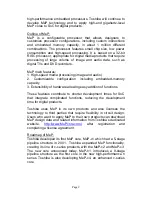
Page 2
high-performance embedded processors. Toshiba will continue to
develop MeP technology and to apply high-end gigahertz-level
MeP cores to SoC for digital products.
Outline of MeP:
MeP is a configurable processor that allows designers to
customize processor configurations, including custom instructions
and embedded memory capacity, in about 1 million different
combinations. The processor features small chip size, low power
consumption and high-speed processing. It is based on a 32-bit
RISC processor, appropriate for digital media products that require
processing of large volume of image and audio data, such as
digital TVs and DVD recorders.
MeP main features:
1. High-speed media processing (image and audio)
2. Customizable configuration, including embedded-memory
capacity
3. Extensibility of hardware allowing easy addition of functions
These features contribute to shorter development times for SoC
that integrate complicated functions, reducing the development
time for digital products.
Toshiba uses MeP in its own products and also licenses the
technology to third parties that require flexibility in circuit design.
Users who want to apply MeP to their own products can download
MeP design data and related information from Toshiba’s dedicated
website,
http://www.MePcore.com/
, after registration and
completing a license agreement.
Roadmap of MeP:
Toshiba developed its first MeP core, MeP-c1 which had a 5-stage
pipeline structure in 2001. Toshiba expanded MeP functionality,
creating its line of c-series products, with the MeP-c2 and MeP-c3.
The new core announced today, MeP-h1, introduces a 9-stage
pipeline structure as the first core in the new high-performance h
series. Toshiba is also developing MeP-c4, an enhanced c-series
core






















